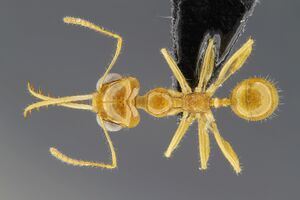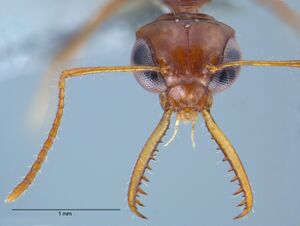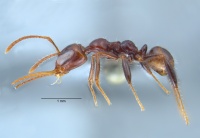Myrmoteras glabrum
| Myrmoteras glabrum | |
|---|---|

| |
| Scientific classification | |
| Kingdom: | Animalia |
| Phylum: | Arthropoda |
| Class: | Insecta |
| Order: | Hymenoptera |
| Family: | Formicidae |
| Subfamily: | Formicinae |
| Tribe: | Myrmoteratini |
| Genus: | Myrmoteras |
| Species: | M. glabrum |
| Binomial name | |
| Myrmoteras glabrum Zettel & Sorger, 2011 | |
Identification
Zettel & Sorger (2011) - Colour mainly dark brown. Dorsum of head smooth. Median frontal sulcus prominent. Gap between clypeus and frons narrow. Labrum not strongly projecting, without long trigger hairs. Mandible with apical part not bent ventrad, with two minute preapical denticles. Disk of pronotum smooth. Dorsum of propodeum strongly convex. Middle tibia strongly dilated, approximately 4.0–4.5 times longer than wide.
Revisions by Moffett (1985) and Agosti (1992) treat all species of Myrmoteras except one later described species, Myrmoteras cuneonodus from Yunnan, southwestern China (Xu 1998). This Myagroteras species (erroneously listed as a species of the nominate subgenus by Bolton et al. 2007) differs from all Philippine species by head sculpture (smooth, but centre rugose). Both revisions contain identifi cation keys. When using Moffett’s (1985) key, Myrmoteras (Myagroteras) glabrum keys with Myrmoteras bakeri Wheeler, 1919, a species recorded from Borneo and Peninsular Malaysia. When using Agosti’s (1992) key, the character combination of M. glabrum “body dark brown + coxae and femora dark brown + mesosoma length < 1.5 mm + propodeum smooth and shining” does not fi t any of the two combinations at couplet 12; but when ignoring dark colour and following 12–, workers of M. glabrum again key with M. bakeri. The differences between M. bakeri and M. glabrum are the following: While M. bakeri is an orange red species, M. glabrum is dark brown with yellowish mandibles, antennae and tarsi. The dorsum of the propodeum is almost flat in M. bakeri, but strongly convex in M. glabrum Furthermore, in M. glabrum the middle tibia is strongly dilated and ca. 4.0–4.5 times as long as broad. This equals a “Tibia Width Index” (= middle tibia width / tibia length × 100) of ca. 22–25, but Moffett (1985) describes this index for M. bakeri differently in key (16–20), diagnosis (> 23) and description (26–27). Differences between M. glabrum and other Philippine species are described in the key.
Keys including this Species
Distribution
Distribution based on Regional Taxon Lists
Indo-Australian Region: Philippines (type locality).
Distribution based on AntMaps
Distribution based on AntWeb specimens
Check data from AntWeb
Countries Occupied
| Number of countries occupied by this species based on AntWiki Regional Taxon Lists. In general, fewer countries occupied indicates a narrower range, while more countries indicates a more widespread species. |

|
Estimated Abundance
| Relative abundance based on number of AntMaps records per species (this species within the purple bar). Fewer records (to the left) indicates a less abundant/encountered species while more records (to the right) indicates more abundant/encountered species. |

|
Biology
Castes
       
| |
| . | Owned by Museum of Comparative Zoology. |
 
| |
| . | |
Nomenclature
The following information is derived from Barry Bolton's Online Catalogue of the Ants of the World.
- glabrum. Myrmoteras (Myagroteras) glabrum Zettel & Sorger, 2011: 62, figs. 1-6, 13 (w.q.) PHILIPPINES (Camiguin I.).
Unless otherwise noted the text for the remainder of this section is reported from the publication that includes the original description.
Description
Worker
Holotype. TL 4.48, HW 0.87, HL 0.88, EL 0.57, ML 1.21, MI 137, SL 0.95, SI 109, PW 0.54, WL 1.28.
Paratype. Range of 19 workers: TL 4.30–4.72, HW 0.83–0.90, MI 135–141, WL 1.18–1.29. Measurements of worker with smallest HW: TL 4.30, HL 0.85, EL 0.53, ML 1.20, MI 141, SL 0.88, SI 106, PW 0.52, WL 1.18. Measurements of worker with largest HW: TL 4.65, HL 0.91, EL 0.59, ML 1.27, MI 140, SL 0.99, SI 110, PW 0.56, WL 1.27.
Colour: Dark brown, posterior half of mesosoma and petiole almost black. (One callow worker with soft integument pale, brown and yellow.) Mandibles and palpi yellow. Antennae brownish yellow. Legs dark brown except bases of tibiae light brown and tarsi pale yellowish.
Structures: Head with sparse pilosity, longest hairs ca. 0.08 mm long. Frons, temples and vertex smooth and shiny. Frons with few faint rugulae anteriorly, median frontal sulcus narrow, neither reaching anterior frons margin nor anterior ocellus. Antennal scrobes indistinct, but anteriomedially limited by short, curved rugae. Temple with blunt ridge separating a flat anterior from slightly convex posterior face. Clypeus with broad posteromedial elevation, with some faint rugae, mostly near margins; anterior margin deeply concave. Mandibles long, smooth, dentition. Maxillary palp with 6, labial palp with 4 segments. Antenna with moderately slender funiculus, each segment less than twice as long as broad (except long ultimate), antennomere 3 slightly shorter than antennomere 2 (in holotype, measured at leading edge, 0.82 times). Mesosoma, node and gaster smooth and sparsely pilose, longest hairs ca. 0.12 mm long: Pronotum low and evenly convex, summit virtually level with anterior of mesonotum. Mesonotum with low, but distinct rugae, irregularly arranged, individually varying from predominately longitudinal to predominately transverse; with pair of distinct ridges extending from metanotal tubercle forward. Metanotal groove visible as feebly impressed notch in lateral aspect. Meso- and metapleura smooth. Propodeum dorsally smooth, in some individuals a few faint rugae indicated. Middle and hind tibiae strongly dilated, middle tibia of holotype 4.3 times as long as wide. Foretibia slender. Node of petiole slender in lateral aspect. Gaster smooth.
Queen
Paratype. TL 4.62, HW 0.91, HL 0.91, EL 0.58, ML 1.20, MI 131, SL 0.95, SI 104, PW 0.61, WL 1.30. Length of forewing 2.88.
Colour: Similar to worker, but head lighter than mesosoma, more orange brown. Wings pale, veins yellow.
Structures: Very similar to worker. MI hardly smaller. Mesosoma differently structured as typical for winged gynes. Pronotum laterally with faint granulation. Mesoscutum posteromedially with some faint rugae. Meso- and metapleura with few longitudinal rugae. Dorsum of propodeum with low but rather distinct rugae. Wing venation as typical for the genus.
Type Material
Holotype (worker) from the Philippines, Camiguin Island, municipality of Mambajao, barangay Tupsan, Macaw Cold Spring, ca. 10 m a.s.l., 09°11'N, 124°46'E, 17 March 2010, leg. H. Zettel & C. V. Pangantihon (# 517).
Paratypes: 17 workers and 1 alate gyne from the same nest as the holotype. 1 worker from the Philippines, Camiguin Island, west of Mambajao proper, Katibawasan spring area, ca. 350 m a.s.l., 15 March 2010, leg. H.Zettel & C. V. Pangantihon (# 515). 1 worker from the Philippines, Camiguin Island, municipality of Mambajao, barangay Dagoocan, spring area, c. 350 m a.s.l., 14 February 2007, leg. H. Zettel (# 472).
Holotypes are deposited in the Entomological Collection of the University of San Carlos, Cebu City, paratypes in the Natural History Museum Vienna and in the authors’ reference collections.
Etymology
The Latin adjective glaber means smooth, and the epithet refers to the smooth surface of the whole body.
References
References based on Global Ant Biodiversity Informatics
- Zettel, H. & D.M. Sorger. 2011. New Myrmoteras ants (Hymenoptera: Formicidae) from the Southeastern Philippines. Raffles Bulletin of Zoology 59(1):61-67

